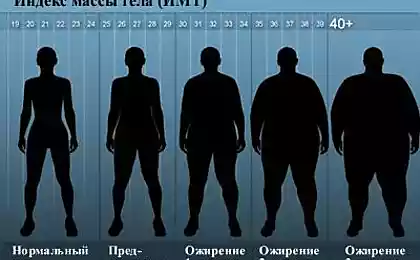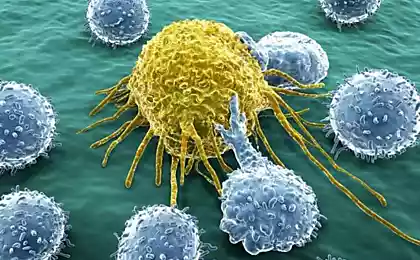1009
Fast and live longer!
In the documentary "Eat, fast and live longer" British writer Michael Mosley explains how he kept the medical post and how this has improved his health. At the beginning of the experiment, blood tests showed high levels of glucose and cholesterol in the blood (the doctor planned to treat him with medication).
Concerned this diagnosis, he decided to explore an alternative approach. The film traveled throughout the United States, met with the centenarians, traditional healers and experts in the field of health. Then he came to the conclusion thatthe most effective for maintaining health is a health post.
Our body is designed for periodic cycles of "feast and famine"
Therapeutic fasting has a number of benefits for the body:
It turns out that the driving force behind the disease process is that we eat too often. When you are in a constant mode of "holiday", your body actually restricts a large part of the inherent nature of the program "renovation and rejuvenation". Hard calorie restriction promotes weight loss and longevity in animal models.
However, for most people, starvation is not very attractive. However, recent studies have shown that the same benefits for the body can be obtained thanks to strict calorie restriction with intermittent therapeutic fasting. It turns out that this is an effective feeding schedule, when you will be feasting for several days, and then drastically reduce the number of calories consumed during the other days.
Medical post reflects the eating habits of our ancestors who did not have round the clock access to grocery stores and food. They combined periods of feast and famine. If we learn to change their eating habits, the body can get healthier.
The health benefits of therapeutic fasting
Fasting is part of many spiritual practices for millennia. Modern science has confirmed that fasting has a therapeutic effect on the human body:
This is one of the main mechanisms that makes the medical post is so useful for health.
Sugar is a source of energy for the body, but also promotes insulin resistance when consumed in large quantities. Insulin resistance, in turn, is a major factor in cardiovascular disease, cancer and other chronic diseases. Intermittent fasting helps the body use fat as the primary fuel.
More and more research confirms that when your body adapts to burning fat instead of sugar as its primary fuel, it significantly reduces the risk of chronic diseases. Normalizes the level of ghrelin (the hunger hormone). Promotes the production of human growth hormone. Studies have shown that therapeutic fasting can raise hormone levels by 1300% in women and 2000% in men. This hormone plays an important role in the health, fitness and slowing the aging process.
Growth hormone also promotes the burning of fat. Because fasting is so effective for weight loss. Reducing triglyceride levels and improving other biomarkers of disease. Reduction of oxidative stress. Post treatment reduces the accumulation of oxidative radicals in the cell and thus prevents oxidative damage to cellular proteins, lipids and nucleic acids associated with aging and chronic diseases.
There were also a lot of studies showing that therapeutic fasting has a beneficial impact on longevity in animals. There are several mechanisms contributing to this effect. Normalization of insulin sensitivity – a major one, but fasting also promotes weight loss and inhibits the aging process.

Intermittent fasting is the most effective way to remove unwanted fat (especially in the waist area!) and eliminate sweet cravings. When sugar is not needed as a primary fuel, your body doesn't need it, even when reserves of glucose in the body runs out.
Fasting also contributes to the prevention and perhaps even treatment of dementia. First, ketones are formed as by-product of burning fat. Second, the ketones (not glucose!) are actually the preferred fuel for the brain.
In addition, periodic therapeutic fasting increases the production of protein –derived neurotrophic factor in the brain, which activates the transformation of brain stem cells into new neurons, and also contributes to the synthesis of many other chemicals that contribute to the health of neurons.
Therapeutic fasting also protects brain cells from changes associated with Alzheimer's disease and Parkinson's disease. Studies have shown that the alternation of day satiety day with lean (restricted diet in the fasting days to about 600 calories) can increase the level atroficescom factor brain from 50 to 400%, depending on the region of the brain.
Intermittent therapeutic fasting 5:2
Intermittent fasting is an umbrella term that covers a wide range of schedules post. Typically, therapeutic fasting involves reducing intake of calories either two days a week, or a day or even every day.
Dr. Mosley in his book suggests to eat normally for five days a week and fast for 2 rest days. This graph can be called "therapeutic fasting 5:2". In the fasting days, he recommends that to reduce caloric intake by up to 25% (about 600 kcal for men and 500 women) and drink plenty of water and tea. Dr. Mosley claims that he has lost 8.5 kg, following treatment intermittent fasting 5:2.
Intermittent fasting healing 1:1
Another popular option is therapeutic fasting in observance of the fasting day a day. If you include sleep time, the duration of the day post can range between 32 and 36 hours. The disadvantage of this method is that each day the post should go to bed hungry (for most people it is very difficult!). If you can follow this post, it will contribute to weight loss and health improvement.
However, the best schedule of treatment post is one that you will follow. If you constantly deceive myself, it will not work.
The study showed that the therapeutic post 1:1 also works well for weight loss as continued adherence to a low calorie diet.
It is much easier to maintain this type of modified starvation mode. In the new study participants in a low-calorie fasting day, eat all the food for the 1st time (lunch or dinner). The division of food, 500 calories into several small meals throughout the day was not as successful as use it for once a day. The main problem related to compliance with this recommendation.
If you're really going to eat only 500 calories a day will lose weight. But if you eat small amounts of food several times a day, you'll want to eat more.

8 hour post treatment
It is also possible to observe the therapeutic post for the day. This method allows the body to quickly move from primary fuel burning sugar to burning fat. Fat is a slow fuel for combustion. If the body begins to burn fat, you cease to "suffer" from lack of sugar. But if you're not hungry not eat for several hours is not too difficult!
8 hour post treatment should be observed until, until increase the body's sensitivity to insulin and leptin (normalization of body weight, arterial blood pressure, cholesterol or diabetes). Then you will continue to follow this therapeutic post as often as you need to maintain your health. You can not eat for 6 hours, until the fat begins to burn as fuel, but there for 9-10 hours
You can only eat for four hours or more before bedtime.
The 8-hour therapeutic fasting is one of the easiest in compliance. It's amazing how quickly disappears craving for food as soon as the body regains its ability to burn fat as fuel. You don't need iron will to keep this feeding schedule. Yes, you will be hungry, but your hunger will be moderate. You will notice that much less food satisfies hunger. The fact that the metabolism takes flexibility; you no longer need to rely on stocks of sugar in their body as a primary fuel.
Has nerasprodannye days?
Therapeutic fasting must become a way of life. Always give preference to healthy products. Learn to imitate their ancient ancestors, who alternated time at the "feast" and hunger. A healthy diet is based on carbohydrate-rich processed foods and replacing them with healthy foods (coconut, olive oil, eggs, avocados and nuts).
Alsobe moderate in protein intake.
Most people should refrain from excessive amounts of fruits (especially as long as not normalized body weight and condition of health).
It usually takes a few weeks to get the body switched to burning fat as its primary fuel. Then automatically disappear the craving for unhealthy food and carbohydrates.
When you reach your ideal body weight, will not suffer from diabetes, high blood pressure or abnormal levels of cholesterol, you can relax a little. However, it makes sense to continue to observe a certain mode of therapeutic fasting, which will help maintain the achieved shape.

Who should not use the medical post?
Post treatment is suitable for most people, but if you suffer from hypoglycemia or diabetes should be very careful. Best intermittent fasting affects people with chronic stress (adrenal fatigue), and impaired regulation of cortisol. Women during pregnancy and lactation also should avoid fasting.
Hypoglycemia is a condition characterized by abnormally low level of blood sugar. This condition is usually associated with diabetes, but you can have hypoglycemia even if you are not diabetic. Common symptoms of hypoglycemia include:
As soon as decreases the level of glucose in the blood, can begin more serious symptoms:
1) confusion and/or abnormal behavior;
2) visual disturbances such as double vision and blurred vision;
3) seizures;
4) loss of consciousness.
One of the keys to eliminating hypoglycemia is to eliminate sugar (especially fructose!) from your diet. It is also helpful to eliminate grains and replace them with higher quality proteins and healthy fats. You can use coconut oil, which contains a quickly metabolized fat. Because coconut oil does not require insulin that can be used during therapeutic fasting as a substitute for sugar.
You should avoid fasting if you suffer from hypoglycemia, and carefully make your diet to normalize blood sugar levels. Then try to observe one of the less strict variants of therapeutic fasting.
Do you suffer from high blood pressure, atherosclerosis, diabetes type 2 diabetes and obesity? Then therapeutic fasting is a healthy alternative to medications.
Also interesting: the Starvation method Marwa Ohanian — treatment of ALL diseases!
Naturopath Rudolf Breus: fasting, healed more than 40 thousand patients
If you follow the post treatment, in two weeks notice, that was gone, sugar cravings, and after two months will be significant changes in your health. You will forget about your chronic incurable diseases and live healthy and free of disease life. After all, fasting has a therapeutic effect on metabolic health.published
Source: globalscience.ru/article/read/25956/
Concerned this diagnosis, he decided to explore an alternative approach. The film traveled throughout the United States, met with the centenarians, traditional healers and experts in the field of health. Then he came to the conclusion thatthe most effective for maintaining health is a health post.
Our body is designed for periodic cycles of "feast and famine"

Therapeutic fasting has a number of benefits for the body:
- improves the health of the cardiovascular system,
- reduces the risk of cancer,
- contributes to the reparation of genes and longevity.
It turns out that the driving force behind the disease process is that we eat too often. When you are in a constant mode of "holiday", your body actually restricts a large part of the inherent nature of the program "renovation and rejuvenation". Hard calorie restriction promotes weight loss and longevity in animal models.
However, for most people, starvation is not very attractive. However, recent studies have shown that the same benefits for the body can be obtained thanks to strict calorie restriction with intermittent therapeutic fasting. It turns out that this is an effective feeding schedule, when you will be feasting for several days, and then drastically reduce the number of calories consumed during the other days.
Medical post reflects the eating habits of our ancestors who did not have round the clock access to grocery stores and food. They combined periods of feast and famine. If we learn to change their eating habits, the body can get healthier.
The health benefits of therapeutic fasting
Fasting is part of many spiritual practices for millennia. Modern science has confirmed that fasting has a therapeutic effect on the human body:
- normalizes the sensitivity of cells to the hormone insulin and the leptin;
- increases the energy efficiency of mitochondria.
This is one of the main mechanisms that makes the medical post is so useful for health.
Sugar is a source of energy for the body, but also promotes insulin resistance when consumed in large quantities. Insulin resistance, in turn, is a major factor in cardiovascular disease, cancer and other chronic diseases. Intermittent fasting helps the body use fat as the primary fuel.
More and more research confirms that when your body adapts to burning fat instead of sugar as its primary fuel, it significantly reduces the risk of chronic diseases. Normalizes the level of ghrelin (the hunger hormone). Promotes the production of human growth hormone. Studies have shown that therapeutic fasting can raise hormone levels by 1300% in women and 2000% in men. This hormone plays an important role in the health, fitness and slowing the aging process.
Growth hormone also promotes the burning of fat. Because fasting is so effective for weight loss. Reducing triglyceride levels and improving other biomarkers of disease. Reduction of oxidative stress. Post treatment reduces the accumulation of oxidative radicals in the cell and thus prevents oxidative damage to cellular proteins, lipids and nucleic acids associated with aging and chronic diseases.
There were also a lot of studies showing that therapeutic fasting has a beneficial impact on longevity in animals. There are several mechanisms contributing to this effect. Normalization of insulin sensitivity – a major one, but fasting also promotes weight loss and inhibits the aging process.

Intermittent fasting is the most effective way to remove unwanted fat (especially in the waist area!) and eliminate sweet cravings. When sugar is not needed as a primary fuel, your body doesn't need it, even when reserves of glucose in the body runs out.
Fasting also contributes to the prevention and perhaps even treatment of dementia. First, ketones are formed as by-product of burning fat. Second, the ketones (not glucose!) are actually the preferred fuel for the brain.
In addition, periodic therapeutic fasting increases the production of protein –derived neurotrophic factor in the brain, which activates the transformation of brain stem cells into new neurons, and also contributes to the synthesis of many other chemicals that contribute to the health of neurons.
Therapeutic fasting also protects brain cells from changes associated with Alzheimer's disease and Parkinson's disease. Studies have shown that the alternation of day satiety day with lean (restricted diet in the fasting days to about 600 calories) can increase the level atroficescom factor brain from 50 to 400%, depending on the region of the brain.
Intermittent therapeutic fasting 5:2
Intermittent fasting is an umbrella term that covers a wide range of schedules post. Typically, therapeutic fasting involves reducing intake of calories either two days a week, or a day or even every day.
Dr. Mosley in his book suggests to eat normally for five days a week and fast for 2 rest days. This graph can be called "therapeutic fasting 5:2". In the fasting days, he recommends that to reduce caloric intake by up to 25% (about 600 kcal for men and 500 women) and drink plenty of water and tea. Dr. Mosley claims that he has lost 8.5 kg, following treatment intermittent fasting 5:2.
Intermittent fasting healing 1:1
Another popular option is therapeutic fasting in observance of the fasting day a day. If you include sleep time, the duration of the day post can range between 32 and 36 hours. The disadvantage of this method is that each day the post should go to bed hungry (for most people it is very difficult!). If you can follow this post, it will contribute to weight loss and health improvement.
However, the best schedule of treatment post is one that you will follow. If you constantly deceive myself, it will not work.
The study showed that the therapeutic post 1:1 also works well for weight loss as continued adherence to a low calorie diet.
It is much easier to maintain this type of modified starvation mode. In the new study participants in a low-calorie fasting day, eat all the food for the 1st time (lunch or dinner). The division of food, 500 calories into several small meals throughout the day was not as successful as use it for once a day. The main problem related to compliance with this recommendation.
If you're really going to eat only 500 calories a day will lose weight. But if you eat small amounts of food several times a day, you'll want to eat more.

8 hour post treatment
It is also possible to observe the therapeutic post for the day. This method allows the body to quickly move from primary fuel burning sugar to burning fat. Fat is a slow fuel for combustion. If the body begins to burn fat, you cease to "suffer" from lack of sugar. But if you're not hungry not eat for several hours is not too difficult!
8 hour post treatment should be observed until, until increase the body's sensitivity to insulin and leptin (normalization of body weight, arterial blood pressure, cholesterol or diabetes). Then you will continue to follow this therapeutic post as often as you need to maintain your health. You can not eat for 6 hours, until the fat begins to burn as fuel, but there for 9-10 hours
You can only eat for four hours or more before bedtime.
The 8-hour therapeutic fasting is one of the easiest in compliance. It's amazing how quickly disappears craving for food as soon as the body regains its ability to burn fat as fuel. You don't need iron will to keep this feeding schedule. Yes, you will be hungry, but your hunger will be moderate. You will notice that much less food satisfies hunger. The fact that the metabolism takes flexibility; you no longer need to rely on stocks of sugar in their body as a primary fuel.
Has nerasprodannye days?
Therapeutic fasting must become a way of life. Always give preference to healthy products. Learn to imitate their ancient ancestors, who alternated time at the "feast" and hunger. A healthy diet is based on carbohydrate-rich processed foods and replacing them with healthy foods (coconut, olive oil, eggs, avocados and nuts).
Alsobe moderate in protein intake.
Most people should refrain from excessive amounts of fruits (especially as long as not normalized body weight and condition of health).
It usually takes a few weeks to get the body switched to burning fat as its primary fuel. Then automatically disappear the craving for unhealthy food and carbohydrates.
When you reach your ideal body weight, will not suffer from diabetes, high blood pressure or abnormal levels of cholesterol, you can relax a little. However, it makes sense to continue to observe a certain mode of therapeutic fasting, which will help maintain the achieved shape.

Who should not use the medical post?
Post treatment is suitable for most people, but if you suffer from hypoglycemia or diabetes should be very careful. Best intermittent fasting affects people with chronic stress (adrenal fatigue), and impaired regulation of cortisol. Women during pregnancy and lactation also should avoid fasting.
Hypoglycemia is a condition characterized by abnormally low level of blood sugar. This condition is usually associated with diabetes, but you can have hypoglycemia even if you are not diabetic. Common symptoms of hypoglycemia include:
- headache,
- weakness,
- tremor,
- irritability,
- hunger.
As soon as decreases the level of glucose in the blood, can begin more serious symptoms:
1) confusion and/or abnormal behavior;
2) visual disturbances such as double vision and blurred vision;
3) seizures;
4) loss of consciousness.
One of the keys to eliminating hypoglycemia is to eliminate sugar (especially fructose!) from your diet. It is also helpful to eliminate grains and replace them with higher quality proteins and healthy fats. You can use coconut oil, which contains a quickly metabolized fat. Because coconut oil does not require insulin that can be used during therapeutic fasting as a substitute for sugar.
You should avoid fasting if you suffer from hypoglycemia, and carefully make your diet to normalize blood sugar levels. Then try to observe one of the less strict variants of therapeutic fasting.
Do you suffer from high blood pressure, atherosclerosis, diabetes type 2 diabetes and obesity? Then therapeutic fasting is a healthy alternative to medications.
Also interesting: the Starvation method Marwa Ohanian — treatment of ALL diseases!
Naturopath Rudolf Breus: fasting, healed more than 40 thousand patients
If you follow the post treatment, in two weeks notice, that was gone, sugar cravings, and after two months will be significant changes in your health. You will forget about your chronic incurable diseases and live healthy and free of disease life. After all, fasting has a therapeutic effect on metabolic health.published
Source: globalscience.ru/article/read/25956/























